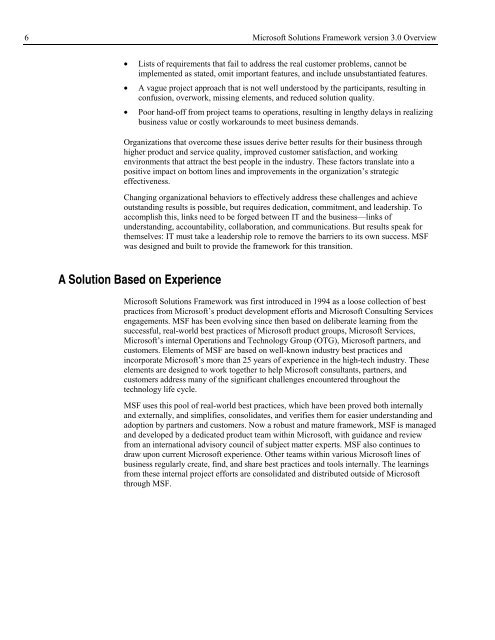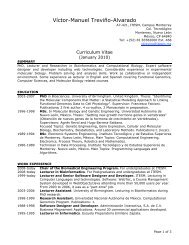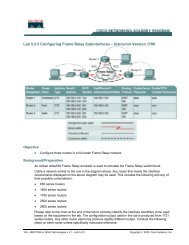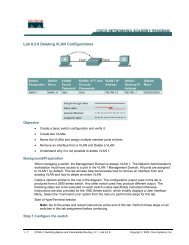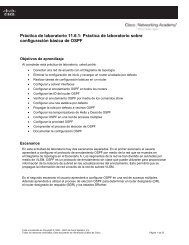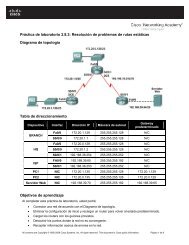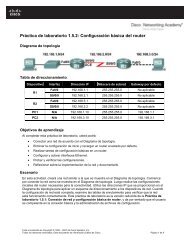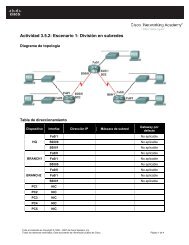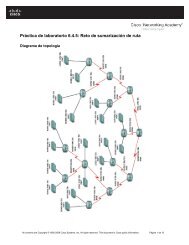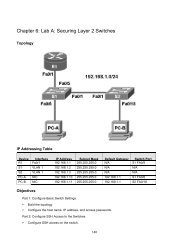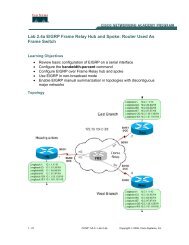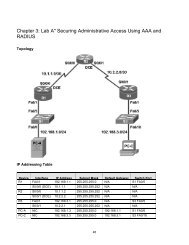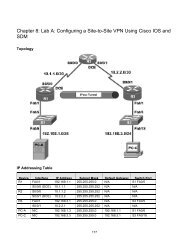White Paper Microsoft Solutions Framework version 3.0 Overview
White Paper Microsoft Solutions Framework version 3.0 Overview
White Paper Microsoft Solutions Framework version 3.0 Overview
Create successful ePaper yourself
Turn your PDF publications into a flip-book with our unique Google optimized e-Paper software.
6 <strong>Microsoft</strong> <strong>Solutions</strong> <strong>Framework</strong> <strong>version</strong> <strong>3.0</strong> <strong>Overview</strong><br />
• Lists of requirements that fail to address the real customer problems, cannot be<br />
implemented as stated, omit important features, and include unsubstantiated features.<br />
• A vague project approach that is not well understood by the participants, resulting in<br />
confusion, overwork, missing elements, and reduced solution quality.<br />
• Poor hand-off from project teams to operations, resulting in lengthy delays in realizing<br />
business value or costly workarounds to meet business demands.<br />
Organizations that overcome these issues derive better results for their business through<br />
higher product and service quality, improved customer satisfaction, and working<br />
environments that attract the best people in the industry. These factors translate into a<br />
positive impact on bottom lines and improvements in the organization’s strategic<br />
effectiveness.<br />
Changing organizational behaviors to effectively address these challenges and achieve<br />
outstanding results is possible, but requires dedication, commitment, and leadership. To<br />
accomplish this, links need to be forged between IT and the business—links of<br />
understanding, accountability, collaboration, and communications. But results speak for<br />
themselves: IT must take a leadership role to remove the barriers to its own success. MSF<br />
was designed and built to provide the framework for this transition.<br />
A Solution Based on Experience<br />
<strong>Microsoft</strong> <strong>Solutions</strong> <strong>Framework</strong> was first introduced in 1994 as a loose collection of best<br />
practices from <strong>Microsoft</strong>’s product development efforts and <strong>Microsoft</strong> Consulting Services<br />
engagements. MSF has been evolving since then based on deliberate learning from the<br />
successful, real-world best practices of <strong>Microsoft</strong> product groups, <strong>Microsoft</strong> Services,<br />
<strong>Microsoft</strong>’s internal Operations and Technology Group (OTG), <strong>Microsoft</strong> partners, and<br />
customers. Elements of MSF are based on well-known industry best practices and<br />
incorporate <strong>Microsoft</strong>’s more than 25 years of experience in the high-tech industry. These<br />
elements are designed to work together to help <strong>Microsoft</strong> consultants, partners, and<br />
customers address many of the significant challenges encountered throughout the<br />
technology life cycle.<br />
MSF uses this pool of real-world best practices, which have been proved both internally<br />
and externally, and simplifies, consolidates, and verifies them for easier understanding and<br />
adoption by partners and customers. Now a robust and mature framework, MSF is managed<br />
and developed by a dedicated product team within <strong>Microsoft</strong>, with guidance and review<br />
from an international advisory council of subject matter experts. MSF also continues to<br />
draw upon current <strong>Microsoft</strong> experience. Other teams within various <strong>Microsoft</strong> lines of<br />
business regularly create, find, and share best practices and tools internally. The learnings<br />
from these internal project efforts are consolidated and distributed outside of <strong>Microsoft</strong><br />
through MSF.


